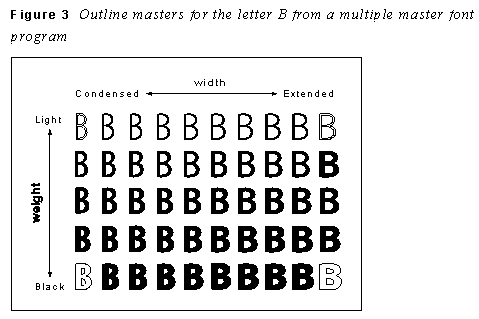
Multiple Master Type 1 Font Programs
Adobe's multiple master font technology is an extension of the Type 1 font format. These fonts contain two or more complete sets of character outlines, bound in a single font program, from which any number of intermediate instances of the font can be generated. A derived instance of a font requires only a small data structure because the character outlines are shared with the main multiple master font program. This minimizes the storage space needed to generate variations once the basic font program is installed.
Adobe Systems will provide multiple master versions of selected typefaces, including support for multiple master technology in printers, support in application products, and a utility to generate individual fonts derived from the master designs. The derived instances of a typeface are installable in existing applications, and each multiple master font package includes code that makes it backward compatible with installed interpreters. Typically, a font program provides master designs for light and bold, as well as condensed and expanded typefaces. Users can then generate instances of styles, such as 70% of the boldest style and 55% of the most expanded design. Figure 3 shows the four outline master designs for the letter B (in outline at the four corners) from a multiple master font program. The inter- mediate characters are instances generated by interpolating between the master designs. Figure 3 Outline masters for the letter B from a multiple master font program

This technology not only gives users greater flexibility and power, but also enables applications to offer the following enhanced features.
Another benefit of multiple master font programs is the ability to generate a version of a character that is optically correct for the size at which it will be viewed. In the age of metal type, character design and spacing were adjusted for the point size of the font. Smaller size fonts typically had proportionally wider spacing, heavier stems and serifs, and less contrast between thick and thin strokes than larger size fonts.
This capability was pretty much lost with photo and digital type technologies, but with the new multiple master technology, typefaces can be rendered optically correct for all sizes. To accomplish this, the multiple master font program must contain one set of outlines designed for use at small sizes and one for use at large sizes.
A multiple master font program can also emulate another typeface if that font's metrics are available. Previously, attempts at substituting or scaling one font to match another usually resulted in unsatisfactory results. A specially designed multiple master font can be scaled to match the metrics of another font in a way that preserves consistent stem widths and spacing characteristics, thus preserving legibility in a manner not previously possible. Font substitution can allow users to open a document for which the referenced fonts are not available, and still get high quality typography when viewing or printing that document.